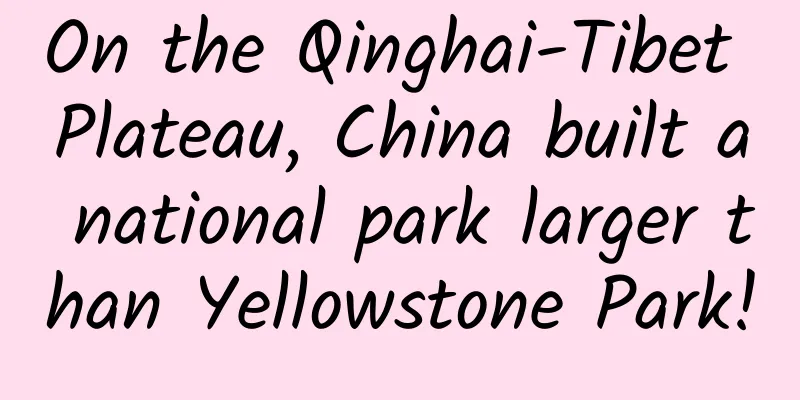On the Qinghai-Tibet Plateau, China built a national park larger than Yellowstone Park!

|
China's first national park is located in the vast land in the northwest of the country - the Sanjiangyuan area of the Qinghai-Tibet Plateau . The Sanjiangyuan is located in the heart of the Qinghai-Tibet Plateau. It is the source and catchment area of the world-famous rivers that have nurtured the long-standing civilization of the Chinese nation and even the Indochina Peninsula: the Yangtze River, the Yellow River and the Lancang River (known as the Mekong River abroad) . It is also known as the "Chinese Water Tower". In 2016, the State Council approved the implementation of the first national park system pilot in Sanjiangyuan. The park consists of three sub-parks: the source of the Yangtze River, the source of the Yellow River, and the source of the Lancang River, with a total area of 123,100 square kilometers. Sanjiangyuan National Park is the first national park built on a pilot basis in my country. It was officially completed in 2021 and has a protected area of 190,700 square kilometers. From now on, China will enter the era of unified management of national parks. So, what exactly are national parks? The American artist George Catlin first proposed the concept of national parks. His original intention was to protect the large tracts of natural wilderness in North America. He hoped that in national parks, both humans and animals could live in the pristine and lively natural beauty. Forty years later, the then President of the United States signed an executive order approving the establishment of a national park in northwestern Wyoming, now the famous Yellowstone National Park. Since then, the construction of national parks has begun to expand from the United States to the entire world, and related concepts such as "species sanctuary", "world heritage" and "biosphere reserve" also originated from the concept of national parks. Currently, the globally recognized concept of national parks comes from the World Conservation Union (IUCN), which defines national parks as protected areas of large areas of natural environment . The goal of national parks has also changed from simply protecting the natural environment to protecting large-scale ecological processes and the balanced development of ecosystems, and under scientific control, research, environmental education and recreational activities can be carried out . At present, there are more than 200 countries and regions in the world that have established different types of national parks. The construction standards of national parks will be different according to the actual conditions of each country. For example, it is impossible to build national parks in China in the same way as those in the UK, because China's geographical environment, from towering mountains to vast plains, is more complex and has richer biodiversity than that of the UK. Why does China build national parks? In fact, China now has many nature reserves. Since the establishment of the first reserve in 1956, the number of reserves has surged to more than 12,000, and the total area of the reserves accounts for 18% of China’s land area . However, the large number of reserves also has a serious problem. Difficult to manage. Because the same protected area is often managed by multiple government departments or agencies, due to the differences in functions between different departments, the government may sometimes ignore some areas that need urgent protection while over-protecting certain areas. To address this issue, in 2015, the National Development and Reform Commission implemented a series of institutional reforms, separating “protected areas” from the seven major departments and now managing them under one department (the National Park Administration) . In addition, the establishment of protected areas often lacks a scientific and complete technical standard system, and there is a lack of standards to stipulate the goals and requirements that protected areas must achieve. Most protected areas are established simply based on local ecological conditions . This has resulted in ineffective “protection” and management of protected areas, and has fostered uncontrolled construction and overdevelopment, especially illegal mining and chaotic hydropower development, a legacy of the country’s booming economy over the past 40 years. National parks were therefore proposed, and the central government hopes to reconstruct China's nature reserve system by establishing national parks. Problems in establishing the park In the process of park development, there is a key issue that needs to be addressed, that is, the local residents. Although the Sanjiangyuan area is located on the Qinghai-Tibet Plateau at a high altitude, there are still nearly 128,000 people living here, most of whom are Tibetans. How to properly resettle them is a problem that must be faced. If we refer to Yellowstone Park in the United States, the US government at that time forced the local Native Americans to resettle outside the park because, according to the 19th century concept, ecological protection required the separation of humans and nature. But it is the 21st century, sir, times have changed , and when establishing a park system at this time, we must consider how to incorporate local residents into its planning rather than uprooting them. To this end, the management bureau has proposed a "one family, one ranger" program, which can provide most of the residents of Sanjiangyuan with conservation-related jobs, such as collecting park garbage and monitoring poachers or illegal grazing herders , and pay them accordingly. Local residents in the lower right corner act as "supervisors" For China, establishing a national park system will be a fresh start. Following the Sanjiangyuan National Park, nine national parks have been piloted, from the ice and snow in Northeast my country to the dense forests in southwestern Sichuan, and further south to Shangri-La in Yunnan. They are the Northeast Tiger and Leopard National Park (involving Jilin Province and Heilongjiang Province), the Giant Panda National Park (involving Sichuan Province, Shaanxi Province and Gansu Province), the Qilian Mountains National Park (involving Gansu Province and Qinghai Province), the Shennongjia National Park (Hubei Province), the Wuyishan National Park (Fujian Province), the Qianjiangyuan National Park (Zhejiang Province), the Nanshan National Park (Hunan Province), the Great Wall National Park (Beijing) and the Shangri-La Pudacuo National Park (Yunnan Province). Is your hometown among them? |
<<: What is sleep paralysis? Is it really caused by ghosts?
>>: I have been wrong for many years! Glasses cloth cannot be used to clean glasses
Recommend
Short video monetization system private training course produced by Director Chen
Brief introduction of the short video monetizatio...
Honor 8 hands-on experience: It’s worth it to spare no effort for the appearance
After experiencing this additional episode of Hon...
up to date! Data rankings of 60 information flow advertising platforms!
Today I bring you the latest traffic rankings of ...
Special planning of the "How Much Do You Know About Nutrition" series | One article explains everything related to high-quality protein
What is protein? Amino acids are the basic units ...
Testin Crash Analysis Breadcrumb Function Sweepers Crash Problems
The concept of breadcrumbs comes from the fairy t...
A new species is launched. Five thousand words will help you understand all the selling points of Huawei Smart Screen
After its Honor product started the trend of TV i...
11 types of locks and performance comparison in iOS development
[[221143]] In daily development, we often use mul...
Original, pure, and magnificent! Explore China's least-known "no man's land"
Human civilization spreads across all continents ...
Cook’s iPhone moment has not come yet!
Click to participate in the 51CTO website content...
7 routines for brand event marketing!
Advertising is like practicing Kung Fu. If you wa...
My eyes are on fire while working from home. How can I cure dry eyes?
Working at a desk for a long time at home, someti...
[Creative Cultivation Program] Why does the promised rainstorm never come?
Author: Wang Zifeng Reviewer: Wang Jinhu, Associa...
How to tap into iOS channels for app promotion
Question 1: I don’t know where to tap into the iO...
Does Facebook really drive 16% of global mobile phone sales?
Facebook recently authorized Deloitte to quantify...
Reuters: European companies’ AI investments need to start showing returns by 2025 as investors lose patience
European companies that have invested heavily in ...









